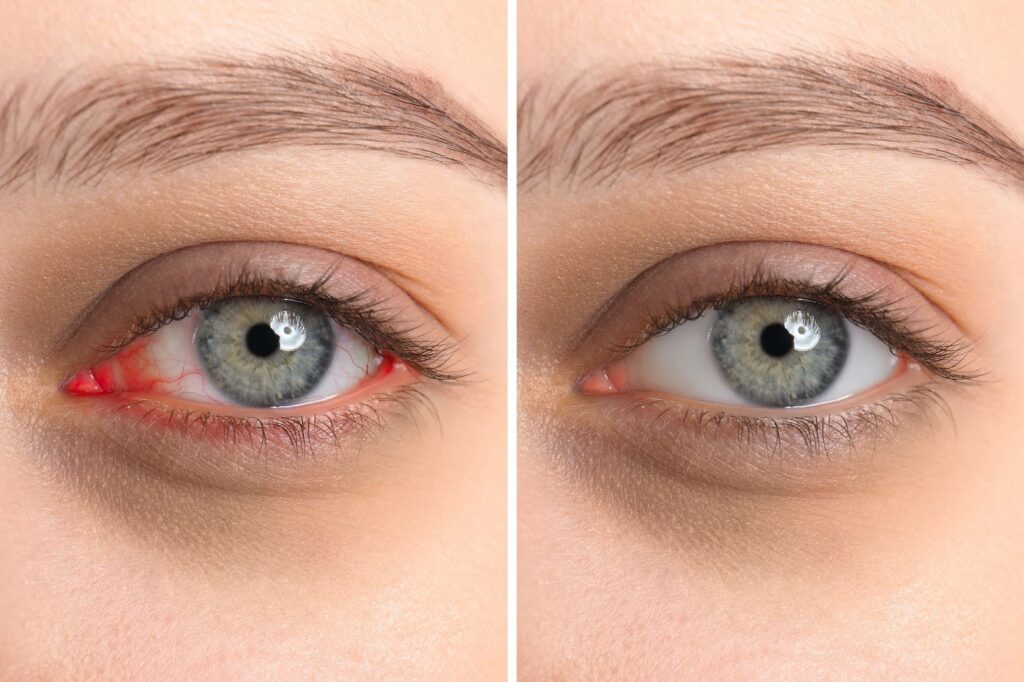When you notice your eyes are red, inflamed, and uncomfortable, it’s rarely a pleasant experience. All kinds of eye conditions, like pink eye and styes, can quickly cause that visible redness. So how can you tell the difference between pink eye and styes, and what can you do about it?
Pink eye inflames the surface of the eye itself and is caused by an infection or allergic reaction. On the other hand, a stye often appears as a small red pump and develops due to an inflamed oil gland or hair follicle.
What Is Pink Eye?
The human eye is complex. It’s made up of plenty of tiny systems and tissues. Inside the eyelid and across the surface of the eye, there’s a small, thin, and transparent tissue liner called the conjunctiva.
When inflamed, this conjunctiva becomes easily irritated and infected. The blood vessels become much more visible, making the entire eye look red or pink. When this happens, it’s called “pink eye” or “conjunctivitis.”
This is an extremely common condition that can affect people at any age. However, there’s a bit of a catch—there isn’t just 1 type of pink eye. There are 3.
The 3 Types of Pink Eye
Pink eye is divided into 3 key subcategories. Each of these has its own cause, symptoms, and treatment depending on what causes the initial inflammation and irritation.
The 3 types of pink eye are:
- Allergic
- Bacterial
- Viral
Allergic Pink Eye
When your body has an allergic reaction, most internal systems go into overdrive. The eye is no exception; it quickly becomes inflamed and irritated. Whether it’s due to pollen, pet dander, or even dust, allergic pink eye can quickly develop due to allergen exposure. There is good news though—allergic pink eye is not contagious.
This often causes:
- Visible redness
- Excessive tearing
- Itchy eyes
- Swelling
- Watery discharge
To treat allergic pink eye, a proactive approach is ideal. Try to minimize your exposure to allergens, and if you start to have a reaction, use over-the-counter antihistamines. If needed, you can use allergic eye drops to reduce your symptoms and find relief.
Bacterial Pink Eye
Bacterial pink eye occurs when bacteria reach the eye’s conjunctiva to set off the symptoms. This is extremely contagious, and can easily be transmitted to other people through direct contact with infected objects, hands, or any spreadable particle.
Unlike allergic pink eye, the bacterial variant can cause a thick visible yellow-green discharge in the eyes. It can also cause:
- Redness in the eye
- Eye pain or soreness
- Swollen eyelids
- Thick yellow or green discharge
- Excessive tearing
To treat bacterial pink eye, it’s essential to consult with an eye care professional. They can prescribe antibiotic eye drops or ointments as needed to clear up the infection.
Viral Pink Eye
Viral pink eye is caused by a virus and is also highly contagious. It can spread rapidly, especially in close environments like schools or workplaces. This type of pink eye often accompanies other viral infections, such as the common cold.
This often causes:
- Watery discharge
- Redness in the eyes
- Itchy or burning sensation
- Light sensitivity
- Swollen lymph nodes near the ear
Unfortunately, there is no specific treatment for viral pink eye. Antibiotics can’t treat this; they don’t work on viral infections. Instead, you’ll need to let the virus run its course.
To find relief, you can use cool compresses and eye drops when needed. Make sure to avoid sharing any personal items like towels or pillowcases to prevent spreading the infection.
What Is a Stye?
A stye, also known as a hordeolum, is a small lump on the eyelid. It can develop on the inside or outside of the eyelid and occurs when an oil gland or hair follicle becomes inflamed.
Unlike pink eye, which affects the conjunctiva, styes can only develop on the eyelids. They occur when bacteria, debris, or oil clogs block the entrance to a follicle or gland, creating a closed environment where bacteria can thrive. They can be painful and cause significant discomfort, but for the most part, styes are rarely contagious.
How to Recognize a Stye
You can often recognize a stye by a visible red bump on the eyelid. It may look like a pimple is trying to burst through your skin. However, it’s important to remember that they can only appear on the eyelids—if you notice significant redness or discharge from your eyes, you’re probably not dealing with a stye.
The common symptoms of a stye include:
- A red, swollen lump on the edge of the eyelid
- Pain or tenderness around the lump
- Increased tearing or watery eyes
- A gritty sensation in the eye
Most styes will go away on their own within a week or so. Never try to pop a stye yourself; this can spread the bacteria around your eyelids and cause worse infections soon after. To speed up the healing process, you can use a warm compress to find relief when needed.
If a stye doesn’t improve, becomes more painful, or starts to affect your vision, talk to your optometrist as soon as you can. They can help reduce the inflammation and may be able to help remove the stye.
When to See Your Optometrist
Understanding the differences between pink eye and styes is the first step to finding relief from your symptoms. If you’re dealing with redness, irritation, or anything unusual with your eyes, come talk to our team here at Virginia Eyecare Clinic. We can give you a proper diagnosis and help you make a plan going forward, so book an appointment with us today!



